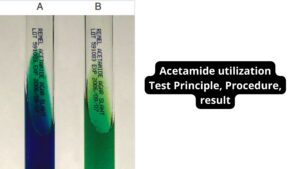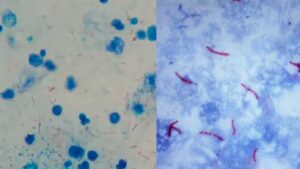Acridine Orange Stain is used for the differentiation of cellular organelles. When the organisms are treated with Acridine Orange, it binds with the nucleic acid ( either DNA or RNA) by the electrostatic interactions and fluoresces to emit various colors.
Acridine Orange contains metachromatic properties, that’s why it is employed in fluorescence microscopy and flow cytometry study of cellular physiology and cell cycle state, including the fluorescent microscopic examination of microorganisms.
Aim
Acridine Orange (AO) stain is a differential staining method of nucleic acids such as RNA and DNA.
Principle of Acridine Orange Staining
AO is a type of fluorochromatic dye, it binds with the nucleic acids (RNA and DNA) of cells and results deoxyribonucleic acid (DNA) to fluoresce green and ribonucleic acid (RNA) or single stranded DNA to fluoresce orange-red under UV light. In 1942, Strugge and Hilbrich first introduced this stain.
Requirements
- Acridine orange acid stain (Store at 15 to 30 °C in the dark).
- Alcohol saline solution(Absolute Methanol)
- Microscopic glass slides
- Heat block at 45 to 60° C (optional)
- Fluorescent microscope
- Immersion oil
Acridine Orange Staining Procedure
- Take a clean grease free glass slide.
- Prepare a smear on it and make a thin layer of specimen.
- Air-dry the smear
- Perform Alcohol fixing by Flooding the smear with methanol.
- Air dry the slide
- Flood the smear with acridine orange stain and wait for 2 minutes.
- Rinse the slide with running tap water.
- Allow to air dry.
- No slide is ready to observe under a microscope by using oil immersion technique.
Result interpretation
- Bacteria and fungi: Appears bright orange.
- Trichomonas vaginalis trichomonads: appears Orange or red with yellow-green nucleus
- Human epithelial and inflammatory cells and tissue debris : appears pale green to yellow.
- Activated leukocytes: appears yellow, orange, or red (depends on the level of activation and amount of RNA produced)
- The background appears black to yellow green.
Limitations
- The acridine orange stain should be clear, orange, and without evidence of precipitate.
- The nucleus or granules of activated leukocytes, and certain types of other cell debris also staine with Acridine orange. Hence, it is challenging to depart them from microorganism.
- Intracellular organisms may be further tedious to recognize by the acridine orange stain, due to the staining of cellular nuclei.
- Acridine orange staining does not discriminate among gram-negative and gram positive organisms.
- The acridine orange stain will be applied to stain some Gram negative which are poorly conceived by Gram staining.
- The sensitivity of the acridine orange smear is around 104 bacteria/ml.



